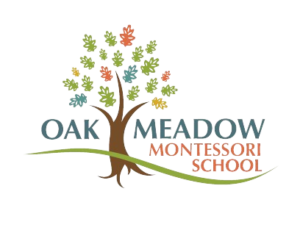Apprenticeship, Mentorship and real life
When I first visited Oak Meadow School last spring, what stood out to me immediately was the multi-age classrooms. It’s a concept that’s very different from any of my previous schools. Parents not familiar with multi-age classrooms might wonder, “why does your school use this approach?”… “does it really work?”… “how will it benefit my child?”
I can think of three big advantages to the Montessori practice of multi-age learning. The first is apprenticeship, where younger children are able to stretch themselves to new levels of accomplishment by observing, interacting with, and following the experience and outcomes of older children. The second is mentorship, which involves older children developing a deeper understanding about their own growth through the experience of explaining challenging concepts to younger children. Third, the concept of multi-age learning is directly aligned with real life–in college, in professions, and interactions all of the time with others from diverse backgrounds and experiences.
 Once we understand the benefits of multi-age learning, we see how this approach can have a transformative impact on education. There is so much more possibility in a school where children are encouraged to work at their own pace, strive to achieve outcomes based on their intrinsic motivation, and have access to examples of more advanced work right in their own classroom.
Once we understand the benefits of multi-age learning, we see how this approach can have a transformative impact on education. There is so much more possibility in a school where children are encouraged to work at their own pace, strive to achieve outcomes based on their intrinsic motivation, and have access to examples of more advanced work right in their own classroom.
Let me share a real example:
Last weekend, four Oak Meadow students (two sixth-year students and two eighth-year students) were selected by independent judges to attend the Massachusetts State Middle School Science & Engineering Fair. Out of the 1,800 students competing in regional events statewide, the judges selected four of our students to attend the State finals. On average, 17% of all students attending regional competitions went on to participate at the State level. For Oak Meadow, 44% of our students were selected to go to the State competition. That means Oak Meadow students outperformed the average by nearly 30%.
 So how did that happen? I was curious about this, so I asked our two sixth-year students what enabled them to perform at such a high competitive level. Here’s what they told me:
So how did that happen? I was curious about this, so I asked our two sixth-year students what enabled them to perform at such a high competitive level. Here’s what they told me:
- “I have watched other students from Oak Meadow over the years. I was very aware of the fact that students from Oak Meadow attend the regional and State competitions, and I knew what it took for those students to be successful with their projects. That inspired me. This year I put in way more effort and work on my project because I wanted to go to the regionals, too. I was so excited to make it to the regional competition. At the awards ceremony, the judges called my name as a finalist and asked me to come up to the podium. I freaked out. I just couldn’t believe it.”
- “During the regionals, I had so much help from other students at Oak Meadow who had already attended in past years. They told me, ‘don’t try to present everything about your project. You only have limited time with the judges, so it’s important to get right to the point in explaining your project.’ I found that advice from more experienced students so helpful in presenting my project to the judges.”
Students will always benefit from the thoughtful coaching and guidance of experienced teachers. We also need to recognize and value how much students learn from each other, and take better advantage of this benefit in our schools. Better student outcomes are the result.





